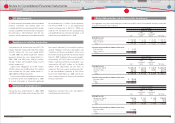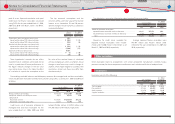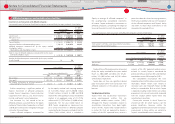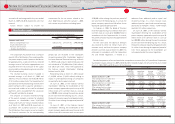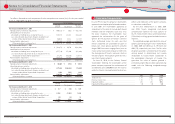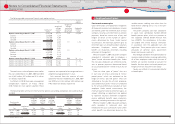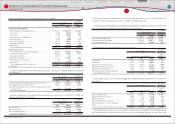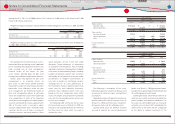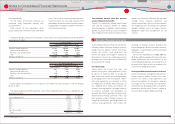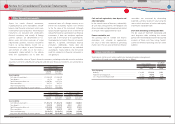Toyota 2010 Annual Report Download - page 81
Download and view the complete annual report
Please find page 81 of the 2010 Toyota annual report below. You can navigate through the pages in the report by either clicking on the pages listed below, or by using the keyword search tool below to find specific information within the annual report.
TOYOTA ANNUAL REPORT 2010 79
Changes in the number of shares of common stock issued have resulted from the following:
For the years ended March 31,
2008 2009 2010
Common stock issued
Balance at beginning of year ·········································································· 3,609,997,492 3,447,997,492 3,447,997,492
Issuance during the year ··················································································· ̶ ̶ ̶
Purchase and retirement ·················································································· (162,000,000) ̶ ̶
Balance at end of year ···················································································· 3,447,997,492 3,447,997,492 3,447,997,492
The Corporation Act provides that an amount
equal to 10% of distributions from surplus paid by
the parent company and its Japanese subsidiaries
be appropriated as a capital reserve or a retained
earnings reserve. No further appropriations are
required when the total amount of the capital
reserve and the retained earnings reserve reaches
25% of stated capital.
The retained earnings reserve included in
retained earnings as of March 31, 2009 and
2010 was ¥167,722 million and ¥168,680 million
($1,813 million), respectively. The Corporation Act
provides that the retained earnings reserve of the
parent company and its Japanese subsidiaries is
restricted and unable to be used for dividend
payments, and is excluded from the calculation
of the profi t available for dividend.
The amounts of statutory retained earnings
of the parent company available for dividend
payments to shareholders were ¥5,624,709
million and ¥5,478,747 million ($58,886 million)
as of March 31, 2009 and 2010, respectively. In
accordance with customary practice in Japan,
the distributions from surplus are not accrued in
the fi nancial statements for the corresponding
period, but are recorded in the subsequent
accounting period after shareholders approval
has been obtained. Retained earnings at March
31, 2010 include amounts representing year-end
cash dividends of ¥78,400 million ($843 million),
¥25 ($0.27) per share, which were approved at
the Ordinary General Shareholders Meeting,
held on June 24, 2010.
Retained earnings at March 31, 2010 include
¥1,344,903 million ($14,455 million) relating to
equity in undistributed earnings of companies
accounted for by the equity method.
On June 23, 2006, at the Ordinary General
Shareholders Meeting, the shareholders of the
parent company approved to purchase up to 30
million shares of its common stock at a cost up
to ¥200,000 million during the purchase period
of one year from the following day. As a result,
the parent company repurchased approximately
28 million shares during the approved period of
time.
On June 22, 2007, at the Ordinary General
Shareholders Meeting, the shareholders of the
parent company approved to purchase up to 30
million shares of its common stock at a cost up to
accrued as of and recognized for the years ended
March 31, 2009 and 2010, respectively, were not
material.
Toyota remains subject to income tax
examination for the tax returns related to the
years beginning on and after January 1, 2000,
with various tax jurisdictions including Japan.
Detailed components of accumulated other comprehensive income (loss) in Toyota Motor Corporation
shareholders equity at March 31, 2009 and 2010 and the related changes, net of taxes for the years ended
March 31, 2008, 2009 and 2010 consist of the following:
Yen in millions
Foreign
currency
translation
adjustments
Unrealized
gains on
securities
Pension
liability
adjustments
Accumulated
other
comprehensive
income (loss)
Balances at March 31, 2007 ················································ ¥ (40,178) ¥ 658,808 ¥ 82,760 ¥ 701,390
Other comprehensive income (loss) ······························ (461,189) (347,829) (133,577) (942,595)
Balances at March 31, 2008 ················································ (501,367) 310,979 (50,817) (241,205)
Other comprehensive income (loss) ······························ (381,303) (293,101) (192,172) (866,576)
Balances at March 31, 2009 ················································ (882,670) 17,878 (242,989) (1,107,781)
Other comprehensive income ··········································· 9,894 176,407 74,645 260,946
Balances at March 31, 2010 ················································ ¥ (872,776) ¥ 194,285 ¥ (168,344) ¥ (846,835)
U.S. dollars in millions
Foreign
currency
translation
adjustments
Unrealized
gains on
securities
Pension
liability
adjustments
Accumulated
other
comprehensive
income (loss)
Balances at March 31, 2009 ················································ $ (9,487) $ 192 $ (2,612) $ (11,907)
Other comprehensive income ··········································· 107 1,896 802 2,805
Balances at March 31, 2010 ················································ $ (9,380) $ 2,088 $ (1,810) $ (9,102)
¥250,000 million during the purchase period of
one year from the following day. As a result, the
parent company repurchased 30 million shares
during the approved period of time.
On February 5, 2008, the Board of Directors
resolved to purchase up to 12 million shares of its
common stock at a cost up to ¥60,000 million in
accordance with the Corporation Act. As a result,
the parent company repurchased approximately
10 million shares.
On the same date, the Board of Directors
also resolved to retire 162 million shares of its
common stock, and then the parent company
retired its common stock on March 31, 2008. This
retirement, in accordance with the Corporation
Act and related regulations, is treated as a
reduction from additional paid-in capital and
retained earnings. As a result, treasury stock,
additional paid-in capital and retained earnings
decreased by ¥646,681 million, ¥3,499 million
and ¥643,182 million, respectively.
On June 24, 2008, at the Ordinary General
Shareholders Meeting, the shareholders of the
parent company approved to purchase up to 30
million shares of its common stock at a cost up
to ¥200,000 million during the purchase period
of one year from the following day. As a result,
the parent company repurchased approximately
14 million shares during the approved period of
time. These approvals by the shareholders are
not required under the current regulation.
Financial Section
Financial Section
Investor Information
Corporate Information
Special Feature
Consolidated
Performance Highlights
Business Overview
Top Messages
Notes to Consolidated Financial Statements
Shareholders equity:
17



